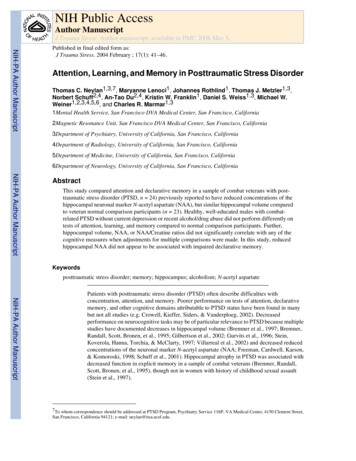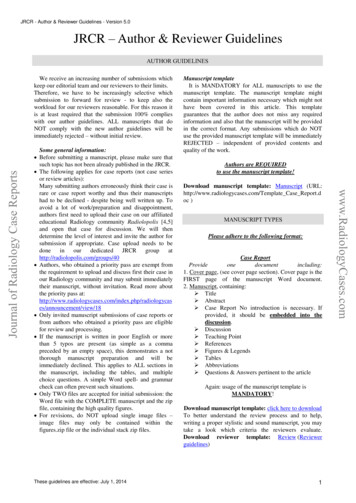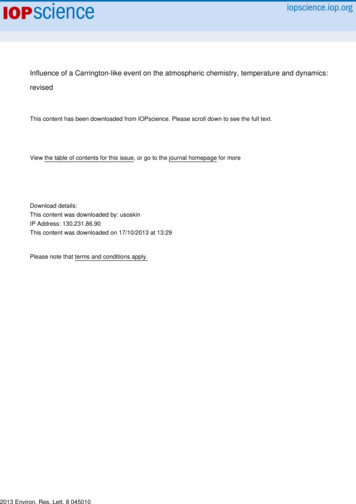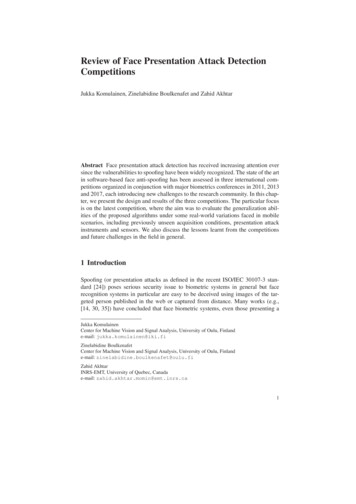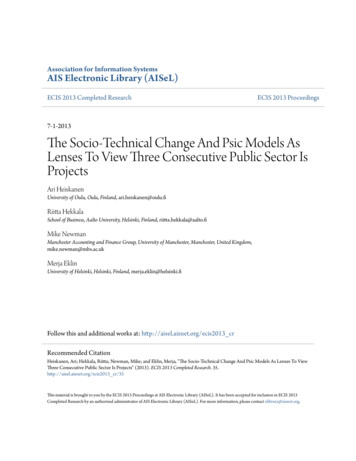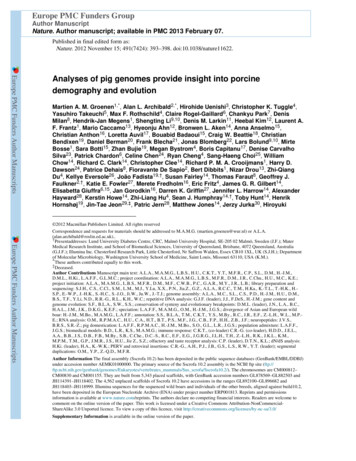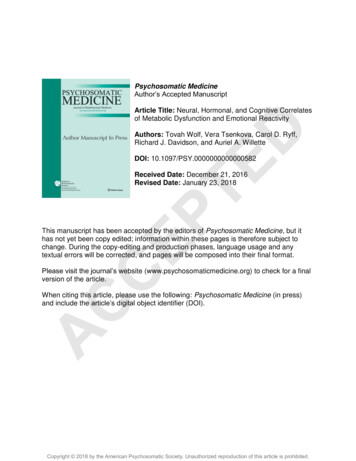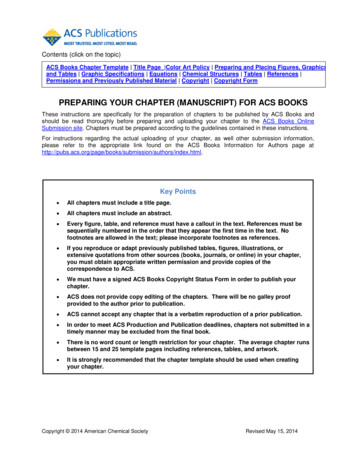
Transcription
Author’s Accepted ManuscriptTransit of H2O2 across the endoplasmic reticulummembrane is not sluggishChristian Appenzeller-Herzog, Gabor Bánhegyi,Ivan Bogeski, Kelvin J.A. Davies, AgnèsDelaunay-Moisan, Henry Jay Forman, AgnesGörlach, Thomas Kietzmann, Francisco Laurindo,Eva Margittai, Andreas J. Meyer, Jan Riemer,Michael Rützler, Thomas Simmen, Roberto Sitia,Michel B. Toledano, Ivo P. .2016.02.030FRB12770To appear in: Free Radical Biology and MedicineReceived date: 16 February 2016Revised date: 23 February 2016Accepted date: 25 February 2016Cite this article as: Christian Appenzeller-Herzog, Gabor Bánhegyi, IvanBogeski, Kelvin J.A. Davies, Agnès Delaunay-Moisan, Henry Jay Forman,Agnes Görlach, Thomas Kietzmann, Francisco Laurindo, Eva Margittai, AndreasJ. Meyer, Jan Riemer, Michael Rützler, Thomas Simmen, Roberto Sitia, MichelB. Toledano and Ivo P. Touw, Transit of H 2O2 across the endoplasmic reticulummembrane is not sluggish, Free Radical Biology and .2016.02.030This is a PDF file of an unedited manuscript that has been accepted forpublication. As a service to our customers we are providing this early version ofthe manuscript. The manuscript will undergo copyediting, typesetting, andreview of the resulting galley proof before it is published in its final citable form.Please note that during the production process errors may be discovered whichcould affect the content, and all legal disclaimers that apply to the journal pertain.
Transit of H2O2 across the endoplasmic reticulum membrane isnot sluggishChristian Appenzeller-Herzog1*, Gabor Bánhegyi2, Ivan Bogeski3, Kelvin J. A. Davies4,5,Agnès Delaunay-Moisan6, Henry Jay Forman4, Agnes Görlach7, Thomas Kietzmann8,Francisco Laurindo9, Eva Margittai10, Andreas J. Meyer11, Jan Riemer12, Michael Rützler13,Thomas Simmen14, Roberto Sitia15, Michel B. Toledano6, and Ivo P. Touw161 Berufsfachschule Gesundheit Baselland, 4142 Münchenstein, Switzerland2 Department of Medical Chemistry, Molecular Biology and Pathobiochemistry, SemmelweisUniversity, Budapest 1428, Hungary3 Department of Biophysics, School of Medicine, University of Saarland, 66421 Homburg,Germany4 Leonard Davis School of Gerontology of the Ethel Percy Andrus Gerontology Center; andDivision of Molecular & Computational Biology, Department of Biological Sciences of theDornsife College of Letters, Arts, and Sciences: The University of Southern California, LosAngeles, CA 90089-0191, USA5 Division of Molecular & Computational Biology, Department of Biological Sciences,Dornsife College of Letters, Arts, and Sciences, The University of Southern California, LosAngeles, CA 90089-0191, USA6 Laboratoire Stress Oxydant et Cancers, CEA-Saclay, Institute for Integrative Biology of theCell (I2BC), 91198 Gif sur Yvette Cedex, France.7 Experimental and Molecular Pediatric Cardiology, German Heart Center Munich at the TUMunich, 80636 Munich, Germany8 Faculty of Biochemistry and Molecular Medicine, University of Oulu, 90210 Oulu, Finland9 Vascular Biology Laboratory, Heart Institute, University of São Paulo School of Medicine,CEP 05403-000 São Paulo, Brazil10 Institute of Human Physiology and Clinical Experimental Research, SemmelweisUniversity, Budapest 1428, Hungary11 INRES - Chemical Signalling, University of Bonn, 53113 Bonn, Germany12 Institute for Biochemistry, University of Cologne, 50674 Cologne, Germany
13 Institute for Health Science and Technology, Aalborg University, DK-9220 Aalborg Ø,Denmark14 Department of Cell Biology, Faculty of Medicine and Dentistry, University of Alberta,Edmonton, Alberta, T6G2H7, Canada15 Protein Transport and Secretion Unit, Division of Genetics and Cell Biology, IRCCS,Ospedale San Raffaele/Universita Vita-Salute San Raffaele, 20132 Milan, Italy16 Erasmus University Medical Center, Department of Hematology, PO Box 2040,Rotterdam, The Netherlands* Correspondence: ,Christian Appenzeller-Herzog, Tel.: 41 61 552 9064, FAX: 41 61 267 1515,Email: christian.appenzeller@sbl.chAbstractCellular metabolism provides various sources of hydrogen peroxide (H2O2) in differentorganelles and compartments. The suitability of H2O2 as an intracellular signaling moleculetherefore also depends on its ability to pass cellular membranes. The propensity of themembranous boundary of the endoplasmic reticulum (ER) to let pass H2O2 has been discussedcontroversially. In this essay, we challenge the recent proposal that the ER membraneconstitutes a simple barrier for H2O2 diffusion and support earlier data showing that (i) ampleH2O2 permeability of the ER membrane is a prerequisite for signal transduction, (ii) aquaporinchannels are crucially involved in the facilitation of H2O2 permeation, and (iii) a properexperimental framework not prone to artifacts is necessary to further unravel the role of H2O2permeation in signal transduction and organelle biology.Principles of reduction-oxidation signalingThe life of a multicellular organism is organized in a complex network of intercellularcommunication. In this vein, individual cells react to external cues such as hormones or otherreceptor-based agonists by the activation of signal transduction cascades, which faithfullytransfer the extracellular signals to the intracellular addressees. Similar processes are activatedalso in single cell organisms in response to pheromones or nutrient signals. The single steps of2
these signaling cascades are designed to proceed by optimized spatial and temporal dynamics[1].An important element in intracellular signal transduction is the transient formation ofdiffusible second messengers, which allow amplification of the signal due to their multipleplaces of action. Amongst many other second messengers, hydrogen peroxide (H2O2) is nowwidely being recognized to serve as such a mobile signaling molecule [2, 3]. H2O2 is one ofthe reactive oxygen species that are produced upon reduction of molecular oxygen and isitself an oxidant. It primarily acts by specifically oxidizing target proteins on specialized,sensitive cysteine residues to modulate their function [4]. Therefore, H2O2-mediated signalingis referred to as reduction-oxidation (redox) signaling. Of note, H2O2 is a relatively poorlyreactive oxidant, which allows it to travel further from its site of generation than cansuperoxide (O2) or hydroxyl radical, before it encounters a peroxidase, catalase orsignaling target [4, 5].A prime example of redox signaling is the role of H2O2 during growth factor-stimulated signaltransduction [6, 7]. Here, the binding of extracellular growth factor ligands to receptortyrosine kinases (RTKs) on the cell surface frequently co-activates members of the NADPHoxidase (Nox) family [8-10]. Nox family members locally produce O2dismutates to H2O2. This increase in O2, which rapidlyand H2O2 generation is required for sustainedreceptor tyrosine phosphorylation and downstream signaling events, because H2O2 inactivatesprotein tyrosine phosphatases (PTPs) on a reactive cysteine in their active site [11, 12].Membrane topology is a critical aspect in this process. The O2-producing active sites ofNox complexes are located on the exoplasmic side of the membrane, whereas PTPs localize tothe cytosol. This topological problem is solved by membrane-embedded aquaporin channels(AQPs). By serving as H2O2 pores they facilitate the formation of local areas with an elevatedH2O2 concentration on both sides of the plasma membrane [13-16].3
H2O2 can readily permeate through the endoplasmic reticulum membraneRTK signaling is not restricted to the plasma membrane. For instance, epidermal growthfactor (EGF) receptor can be internalized upon stimulation by endocytosis and brought intoproximity with the endoplasmic reticulum (ER) membrane [17]. As a notable consequence,ER-associated proteins such as Nox4 [18, 19] and the phosphatase PTP1b [20-22] playimportant roles during EGF receptor signaling by acting in analogy to their cognate signalingcomponents at the plasma membrane [17]. Nox4, which can directly, i.e. irrespective of adismutase, generate H2O2 in the ER lumen [23-27], is coupled to the transient oxidativeinactivation of PTP1b on the cytosolic side of the ER membrane [17]. This sequence of eventspremises that H2O2 must be able to pass the ER membrane at a time scale that copes withEGF receptor signaling.While observations of redox signaling at the ER are relatively scarce at this stage, it is clearthat H2O2 is widely utilized as a signaling molecule in vivo [28] and it is quite predictable thatfurther mechanisms specific to the ER will be uncovered in the future [18]. Other examples,which are connected to H2O2 transit across the ER membrane, are granulocyte colonystimulating factor receptor signaling [29], oxidative DNA damage in response to cellularstresses [30-32], activation of survival pathways upon H2O2 generation in the ER [33, 34], andthe regulatory roles of ER-luminal peroxidases in various settings of cytosolic signaltransduction [29, 35-38]. These findings clearly indicate the permeability of the ERmembrane for H2O2.Ample H2O2 permeability at the ER membrane has additionally been demonstrated bystudying over-expressed ER oxidoreductin 1(Ero1 ). This ER-luminal oxidase producesH2O2, which is immediately detoxified by the Ero1 -associated peroxidase GPx8 [18].Depletion of GPx8, however, leads to the overflow of H2O2 to the cytosol [39]. By contrast,4
ty-high-turnover-peroxidaseperoxiredoxin 4 [40, 41] does not cause similar leakage of Ero1 -derived H2O2 into thecytosol [39]. Thus, the shielding of the cytosol against Ero1 -derived H2O2 takes place at theEro1 -GPx8 interface through catalytic elimination [42]. If hindered diffusion of H2O2 at theER membrane was to provide an additional shielding mechanism, Ero1 -derived H2O2 wouldcertainly be eliminated by peroxiredoxin 4 already within the ER and not found in the cytosolupon depletion of GPx8.Aquaporins regulate the permeability of the ER membrane to H2O2Is the transport of H2O2 at the ER facilitated by AQPs in analogy to the situation at the plasmamembrane? AQP8 fulfills a major function in the transport of H2O2 at the plasma membrane[13]. In addition, knockdown of AQP8 strongly diminishes the entry of exogenous H2O2 intothe ER of plasma membrane-permeabilized cells [13]. This indicates that AQP8 canaccelerate the transit of H2O2 also across the ER membrane when expressed at physiologicallevels. Since cell surface AQP8 is synthesized at the ER before trafficking to the plasmamembrane, a physiological function in the ER is conceivable. This is also supported by itssteady-state localization both at the plasma membrane and in “intracellular vesicles” [43]. Inaddition, AQP8 appears to be involved in the transit of H2O2 from mitochondria in certain celltypes [44].AQP8 and other AQPs show specific tissue distributions. The rich collection of human AQPsenables a versatile regulation of transmembrane permeation of water throughout the body byharboring specific differences in transcriptional regulation, post-translational modification,protein stability, water permeability, and subcellular distribution [43]. Accordingly, it is likelythat AQPs other than AQP8 play complementary, tissue- and context-specific roles with5
regard to H2O2 transport at the ER. One obvious candidate is AQP11, the subcellularlocalization of which is strongly shifted to the ER [45, 46]. AQP11 loss-of-function causesdestructive symptoms of ER stress, which mainly manifest in the proximal tubular epithelialcells of the kidney [45-47] but also in other organs such as the liver [48]. The failure ofAQP11-deficient cells is accompanied by elevated levels of intracellular H2O2 [45]. Whetheror not ER stress and H2O2 dysregulation are linked to a change in H2O2 permeability of theER membrane remains to be shown.In addition to the tissue-specific expression level of ER AQPs, the H2O2 permeability of theER membrane is likely regulated by post-translational modifications. For instance, thepermeability of AQP8 is reversibly inhibited in response to diverse stress conditions throughthe targeting of cysteine 53 (Iria Medraño-Fernandez, Stefano Bestetti, and R.S.; unpublishedobservations) and the overproduction of ER-luminal H2O2 appears to stimulate its ownpassage through the ER membrane in liver cells of living mice [49].Based on biophysical and structural data, it has been deduced that all AQPs that are able totransport water can also transport H2O2 [50]. Thus, not only the highly conductingaquaammoniaporin AQP8 but also the water-permeable AQP11 is predicted to serve as abona fide H2O2 channel.The ER membrane is not refractory to rapid H2O2 diffusionIn a recent publication, the ER membrane was postulated to comprise a significant barrier toH2O2 diffusion [51]. This postulate was based on an experiment, in which oxidation ofintracellular H2O2 probes in response to increasing concentrations of extracellular H2O2 wererecorded. As already worked out elsewhere [39], the H2O2-dependent oxidation of thegenetically encoded probe HyPer [52] was recorded upon concomitant addition of the6
disulfide reductant dithiothreitol (DTT). In this setup, ER-targeted HyPer was less readilyoxidized than cytosolic HyPer [51]. This appears to be a trivial observation though, asexogenous H2O2 on its way to the ER must cross the cytosol, which is equipped with aplethora of powerful peroxidases. In a comparable experimental setup, most H2O2 wasconsumed before it could reach the depth of the cell [53]. Konno et al. addressed this issue byusing a cell line that expresses relatively low levels of some cellular antioxidant enzymes[51], a measure that can modulate but not eliminate the problem of cytosolic dissipation ofH2O2. The less efficient oxidation of ER-targeted HyPer compared to cytosolic HyPertherefore cannot only be interpreted to reflect hampered permeability of the ER membrane toH2O2.In addition to cytosolic and ER-targeted HyPer, Konno et al. used mitochondrial HyPer,which showed similar H2O2-induced fluorescence changes as cytosolic HyPer [51]. This issurprising, because, as for the ER, mitochondria can only be reached via the cytosol, whichwould be expected to decrease the H2O2-sensitivity of mitochondrial HyPer below thesensitivity of cytosolic HyPer (see above). How can this be explained? HyPer is not onlysensitive to oxidation but also to alkalinisation [52], which is typically controlled for by alsoanalyzing the response of cysteine-mutant HyPer [54]. Of potential relevance, treatment ofcells with H2O2 induces the transient alkalinisation of the mitochondrial matrix [55].Furthermore, we note that the responses to extracellular H2O2 of chemical, pH-independentH2O2 sensors are similarly slow in mitochondria and ER and slightly faster in cytosol andnucleus [56]. Apart from pH, other organelle-specific differences in the handling of HyPercould also be relevant. It is possible, for example, that the rich collection of thiol-disulfideisomerases in the ER (for review see [23, 57]) catalyzes the reduction of ER-targeted HyPerby DTT particularly well. This in turn would decrease the net steady-state oxidation of ERtargeted HyPer as compared to mitochondrial HyPer at the lower doses of H2O2, as has beenobserved [51]. Although these explanations are yet hypothetical, we suggest that some7
mitochondrion-specific feature rather than the relative impermeability of the ER membranecauses the more pronounced response to H2O2 of mitochondrial HyPer compared to ERtargeted HyPer.In summary, all published data strongly support the notion that facilitated permeability toH2O2 is a designated and likely regulated feature of the ER membrane, which is in line withthe central signaling role of this fascinating organelle.References[1]Kholodenko, B. N. Cell-signalling dynamics in time and space. Nat Rev Mol Cell Biol 7:165-176;2006.[2]Forman, H. J.; Maiorino, M.; Ursini, F. Signaling functions of reactive oxygen species.Biochemistry 49:835-842; 2010.[3]Veal, E.; Day, A. Hydrogen peroxide as a signaling molecule. Antioxid Redox Signal 15:147151; 2011.[4]Holmstrom, K. M.; Finkel, T. Cellular mechanisms and physiological consequences of redoxdependent signalling. Nat Rev Mol Cell Biol 15:411-421; 2014.[5]Winterbourn, C. C. Reconciling the chemistry and biology of reactive oxygen species. NatChem Biol 4:278-286; 2008.[6]Sundaresan, M.; Yu, Z. X.; Ferrans, V. J.; Irani, K.; Finkel, T. Requirement for generation ofH2O2 for platelet-derived growth factor signal transduction. Science 270:296-299; 1995.[7]Bae, Y. S.; Kang, S. W.; Seo, M. S.; Baines, I. C.; Tekle, E.; Chock, P. B.; Rhee, S. G. Epidermalgrowth factor (EGF)-induced generation of hydrogen peroxide. Role in EGF receptor-mediatedtyrosine phosphorylation. J Biol Chem 272:217-221; 1997.[8]Park, H. S.; Lee, S. H.; Park, D.; Lee, J. S.; Ryu, S. H.; Lee, W. J.; Rhee, S. G.; Bae, Y. S. Sequentialactivation of phosphatidylinositol 3-kinase, beta Pix, Rac1, and Nox1 in growth factor-inducedproduction of H2O2. Mol Cell Biol 24:4384-4394; 2004.[9]Petry, A.; Weitnauer, M.; Gorlach, A. Receptor activation of NADPH oxidases. Antioxid RedoxSignal 13:467-487; 2010.[10]Truong, T. H.; Carroll, K. S. Redox regulation of epidermal growth factor receptor signalingthrough cysteine oxidation. Biochemistry 51:9954-9965; 2012.[11]Denu, J. M.; Tanner, K. G. Specific and reversible inactivation of protein tyrosinephosphatases by hydrogen peroxide: evidence for a sulfenic acid intermediate and implications forredox regulation. Biochemistry 37:5633-5642; 1998.[12]Meng, T. C.; Fukada, T.; Tonks, N. K. Reversible oxidation and inactivation of protein tyrosinephosphatases in vivo. Mol Cell 9:387-399; 2002.[13]Bertolotti, M.; Bestetti, S.; Garcia-Manteiga, J. M.; Medrano-Fernandez, I.; Dal Mas, A.;Malosio, M. L.; Sitia, R. Tyrosine kinase signal modulation: a matter of H2O2 membranepermeability? Antioxid Redox Signal 19:1447-1451; 2013.[14]Hara-Chikuma, M.; Chikuma, S.; Sugiyama, Y.; Kabashima, K.; Verkman, A. S.; Inoue, S.;Miyachi, Y. Chemokine-dependent T cell migration requires aquaporin-3-mediated hydrogenperoxide uptake. J Exp Med 209:1743-1752; 2012.[15]Miller, E. W.; Dickinson, B. C.; Chang, C. J. Aquaporin-3 mediates hydrogen peroxide uptaketo regulate downstream intracellular signaling. Proc Natl Acad Sci U S A 107:15681-15686; 2010.8
[16]Vieceli Dalla Sega, F.; Zambonin, L.; Fiorentini, D.; Rizzo, B.; Caliceti, C.; Landi, L.; Hrelia, S.;Prata, C. Specific aquaporins facilitate Nox-produced hydrogen peroxide transport through plasmamembrane in leukaemia cells. Biochim Biophys Acta 1843:806-814; 2014.[17]Chen, K.; Kirber, M. T.; Xiao, H.; Yang, Y.; Keaney, J. F., Jr. Regulation of ROS signaltransduction by NADPH oxidase 4 localization. J Cell Biol 181:1129-1139; 2008.[18]Delaunay-Moisan, A.; Appenzeller-Herzog, C. The antioxidant machinery of the endoplasmicreticulum: Protection and signaling. Free Radic Biol Med 83:341-351; 2015.[19]Laurindo, F. R.; Araujo, T. L.; Abrahao, T. B. Nox NADPH oxidases and the endoplasmicreticulum. Antioxid Redox Signal 20:2755-2775; 2014.[20]Frangioni, J. V.; Beahm, P. H.; Shifrin, V.; Jost, C. A.; Neel, B. G. The nontransmembranetyrosine phosphatase PTP-1B localizes to the endoplasmic reticulum via its 35 amino acid C-terminalsequence. Cell 68:545-560; 1992.[21]Salmeen, A.; Andersen, J. N.; Myers, M. P.; Meng, T. C.; Hinks, J. A.; Tonks, N. K.; Barford, D.Redox regulation of protein tyrosine phosphatase 1B involves a sulphenyl-amide intermediate.Nature 423:769-773; 2003.[22]van Montfort, R. L.; Congreve, M.; Tisi, D.; Carr, R.; Jhoti, H. Oxidation state of the active-sitecysteine in protein tyrosine phosphatase 1B. Nature 423:773-777; 2003.[23]Gorlach, A.; Klappa, P.; Kietzmann, T. The endoplasmic reticulum: folding, calciumhomeostasis, signaling, and redox control. Antioxid Redox Signal 8:1391-1418; 2006.[24]Martyn, K. D.; Frederick, L. M.; von Loehneysen, K.; Dinauer, M. C.; Knaus, U. G. Functionalanalysis of Nox4 reveals unique characteristics compared to other NADPH oxidases. Cell Signal 18:6982; 2006.[25]Nisimoto, Y.; Diebold, B. A.; Cosentino-Gomes, D.; Lambeth, J. D. Nox4: a hydrogen peroxidegenerating oxygen sensor. Biochemistry 53:5111-5120; 2014.[26]Serrander, L.; Cartier, L.; Bedard, K.; Banfi, B.; Lardy, B.; Plastre, O.; Sienkiewicz, A.; Forro, L.;Schlegel, W.; Krause, K. H. NOX4 activity is determined by mRNA levels and reveals a unique patternof ROS generation. Biochem J 406:105-114; 2007.[27]Takac, I.; Schroder, K.; Zhang, L.; Lardy, B.; Anilkumar, N.; Lambeth, J. D.; Shah, A. M.; Morel,F.; Brandes, R. P. The E-loop is involved in hydrogen peroxide formation by the NADPH oxidase Nox4.J Biol Chem 286:13304-13313; 2011.[28]Zhang, H.; Davies, K. J.; Forman, H. J. Oxidative stress response and Nrf2 signaling in aging.Free Radic Biol Med 88:314-336; 2015.[29]Palande, K.; Roovers, O.; Gits, J.; Verwijmeren, C.; Iuchi, Y.; Fujii, J.; Neel, B. G.; Karisch, R.;Tavernier, J.; Touw, I. P. Peroxiredoxin-controlled G-CSF signalling at the endoplasmic reticulum-earlyendosome interface. J Cell Sci 124:3695-3705; 2011.[30]Dvash, E.; Har-Tal, M.; Barak, S.; Meir, O.; Rubinstein, M. Leukotriene C4 is the major triggerof stress-induced oxidative DNA damage. Nat Commun 6:10112; 2015.[31]Fazeli, G.; Stopper, H.; Schinzel, R.; Ni, C. W.; Jo, H.; Schupp, N. Angiotensin II induces DNAdamage via AT1 receptor and NADPH oxidase isoform Nox4. Mutagenesis 27:673-681; 2012.[32]Weyemi, U.; Lagente-Chevallier, O.; Boufraqech, M.; Prenois, F.; Courtin, F.; Caillou, B.;Talbot, M.; Dardalhon, M.; Al Ghuzlan, A.; Bidart, J. M.; Schlumberger, M.; Dupuy, C. ROS-generatingNADPH oxidase NOX4 is a critical mediator in oncogenic H-Ras-induced DNA damage and subsequentsenescence. Oncogene 31:1117-1129; 2012.[33]Santos, C. X.; Hafstad, A. D.; Beretta, M.; Zhang, M.; Molenaar, C.; Kopec, J.; Fotinou, D.;Murray, T. V.; Cobb, A. M.; Martin, D.; Zeh Silva, M.; Anilkumar, N.; Schroder, K.; Shanahan, C. M.;Brewer, A. C.; Brandes, R. P.; Blanc, E.; Parsons, M.; Belousov, V.; Cammack, R.; Hider, R. C.; Steiner,R. A.; Shah, A. M. Targeted redox inhibition of protein phosphatase 1 by Nox4 regulates eIF2alphamediated stress signaling. EMBO J; 2016.[34]Wu, R. F.; Ma, Z.; Liu, Z.; Terada, L. S. Nox4-derived H2O2 mediates endoplasmic reticulumsignaling through local Ras activation. Mol Cell Biol 30:3553-3568; 2010.[35]Bosello-Travain, V.; Forman, H. J.; Roveri, A.; Toppo, S.; Ursini, F.; Venerando, R.; Warnecke,C.; Zaccarin, M.; Maiorino, M. Glutathione Peroxidase 8 is transcriptionally regulated by HIFalpha andmodulates growth factor signaling in HeLa cells. Free Radic Biol Med in press; 2015.9
[36]Chang, Y. C.; Yu, Y. H.; Shew, J. Y.; Lee, W. J.; Hwang, J. J.; Chen, Y. H.; Chen, Y. R.; Wei, P. C.;Chuang, L. M.; Lee, W. H. Deficiency of NPGPx, an oxidative stress sensor, leads to obesity in miceand human. EMBO Mol Med 5:1165-1179; 2013.[37]Peng, D.; Belkhiri, A.; Hu, T.; Chaturvedi, R.; Asim, M.; Wilson, K. T.; Zaika, A.; El-Rifai, W.Glutathione peroxidase 7 protects against oxidative DNA damage in oesophageal cells. Gut 61:12501260; 2012.[38]Peng, D.; Hu, T.; Soutto, M.; Belkhiri, A.; Zaika, A.; El-Rifai, W. Glutathione peroxidase 7 haspotential tumour suppressor functions that are silenced by location-specific methylation inoesophageal adenocarcinoma. Gut 63:540-551; 2014.[39]Ramming, T.; Hansen, H. G.; Nagata, K.; Ellgaard, L.; Appenzeller-Herzog, C. GPx8 peroxidaseprevents leakage of H2O2 from the endoplasmic reticulum. Free Radic Biol Med 70:106-116; 2014.[40]Gidalevitz, T.; Stevens, F.; Argon, Y. Orchestration of secretory protein folding by ERchaperones. Biochim Biophys Acta 1833:2410-2424; 2013.[41]Wang, X.; Wang, L.; Sun, F.; Wang, C. C. Structural insights into the peroxidase activity andinactivation of human peroxiredoxin 4. Biochem J 441:113-118; 2012.[42]Ramming, T.; Okumura, M.; Kanemura, S.; Baday, S.; Birk, J.; Moes, S.; Spiess, M.; Jeno, P.;Berneche, S.; Inaba, K.; Appenzeller-Herzog, C. A PDI-catalyzed thiol-disulfide switch regulates theproduction of hydrogen peroxide by human Ero1. Free Radic Biol Med 83:361-372; 2015.[43]King, L. S.; Kozono, D.; Agre, P. From structure to disease: the evolving tale of aquaporinbiology. Nat Rev Mol Cell Biol 5:687-698; 2004.[44]Marchissio, M. J.; Frances, D. E.; Carnovale, C. E.; Marinelli, R. A. Mitochondrial aquaporin-8knockdown in human hepatoma HepG2 cells causes ROS-induced mitochondrial depolarization andloss of viability. Toxicol Appl Pharmacol 264:246-254; 2012.[45]Atochina-Vasserman, E. N.; Biktasova, A.; Abramova, E.; Cheng, D. S.; Polosukhin, V. V.;Tanjore, H.; Takahashi, S.; Sonoda, H.; Foye, L.; Venkov, C.; Ryzhov, S. V.; Novitskiy, S.; Shlonimskaya,N.; Ikeda, M.; Blackwell, T. S.; Lawson, W. E.; Gow, A. J.; Harris, R. C.; Dikov, M. M.; Tchekneva, E. E.Aquaporin 11 insufficiency modulates kidney susceptibility to oxidative stress. Am J Physiol RenalPhysiol 304:F1295-1307; 2013.[46]Okada, S.; Misaka, T.; Tanaka, Y.; Matsumoto, I.; Ishibashi, K.; Sasaki, S.; Abe, K. Aquaporin-11knockout mice and polycystic kidney disease animals share a common mechanism of cyst formation.FASEB J 22:3672-3684; 2008.[47]Morishita, Y.; Matsuzaki, T.; Hara-chikuma, M.; Andoo, A.; Shimono, M.; Matsuki, A.;Kobayashi, K.; Ikeda, M.; Yamamoto, T.; Verkman, A.; Kusano, E.; Ookawara, S.; Takata, K.; Sasaki, S.;Ishibashi, K. Disruption of aquaporin-11 produces polycystic kidneys following vacuolization of theproximal tubule. Mol Cell Biol 25:7770-7779; 2005.[48]Rojek, A.; Fuchtbauer, E. M.; Fuchtbauer, A.; Jelen, S.; Malmendal, A.; Fenton, R. A.; Nielsen,S. Liver-specific Aquaporin 11 knockout mice show rapid vacuolization of the rough endoplasmicreticulum in periportal hepatocytes after amino acid feeding. Am J Physiol Gastrointest Liver Physiol304:G501-515; 2013.[49]Margittai, E.; Low, P.; Szarka, A.; Csala, M.; Benedetti, A.; Banhegyi, G. Intraluminal hydrogenperoxide induces a permeability change of the endoplasmic reticulum membrane. FEBS Lett582:4131-4136; 2008.[50]Almasalmeh, A.; Krenc, D.; Wu, B.; Beitz, E. Structural determinants of the hydrogen peroxidepermeability of aquaporins. FEBS J 281:647-656; 2014.[51]Konno, T.; Pinho Melo, E.; Lopes, C.; Mehmeti, I.; Lenzen, S.; Ron, D.; Avezov, E. ERO1independent production of H2O2 within the endoplasmic reticulum fuels Prdx4-mediated oxidativeprotein folding. J Cell Biol 211:253-259; 2015.[52]Belousov, V. V.; Fradkov, A. F.; Lukyanov, K. A.; Staroverov, D. B.; Shakhbazov, K. S.; Terskikh,A. V.; Lukyanov, S. Genetically encoded fluorescent indicator for intracellular hydrogen peroxide. NatMethods 3:281-286; 2006.[53]Lim, J. B.; Langford, T. F.; Huang, B. K.; Deen, W. M.; Sikes, H. D. A reaction-diffusion model ofcytosolic hydrogen peroxide. Free Radic Biol Med 90:85-90; 2016.10
[54]Poburko, D.; Santo-Domingo, J.; Demaurex, N. Dynamic regulation of the mitochondrialproton gradient during cytosolic calcium elevations. J Biol Chem 286:11672-11684; 2011.[55]Schwarzlander, M.; Logan, D. C.; Johnston, I. G.; Jones, N. S.; Meyer, A. J.; Fricker, M. D.;Sweetlove, L. J. Pulsing of membrane potential in individual mitochondria: a stress-inducedmechanism to regulate respiratory bioenergetics in Arabidopsis. Plant Cell 24:1188-1201; 2012.[56]Srikun, D.; Albers, A. E.; Nam, C. I.; Iavarone, A. T.; Chang, C. J. Organelle-targetablefluorescent probes for imaging hydrogen peroxide in living cells via SNAP-Tag protein labeling. J AmChem Soc 132:4455-4465; 2010.[57]Appenzeller-Herzog, C.; Ellgaard, L. The human PDI family: versatility packed into a singlefold. Biochim Biophys Acta 1783:535-548; 2008.HighlightsAmple H2O2 permeability of the ER membrane is critical for signal transductionAquaporins facilitate the transmembrane permeation of H2O2The ER H2O2 pool appears not to be isolated from other cell compartments11
proximity with the endoplasmic reticulum (ER) membrane [17]. As a notable consequence, ER-associated proteins such as Nox4 [18, 19] and the phosphatase PTP1b [20-22] play important roles during EGF receptor signaling by acting in analogy to their cognate signaling components at the plasma membrane [17].


